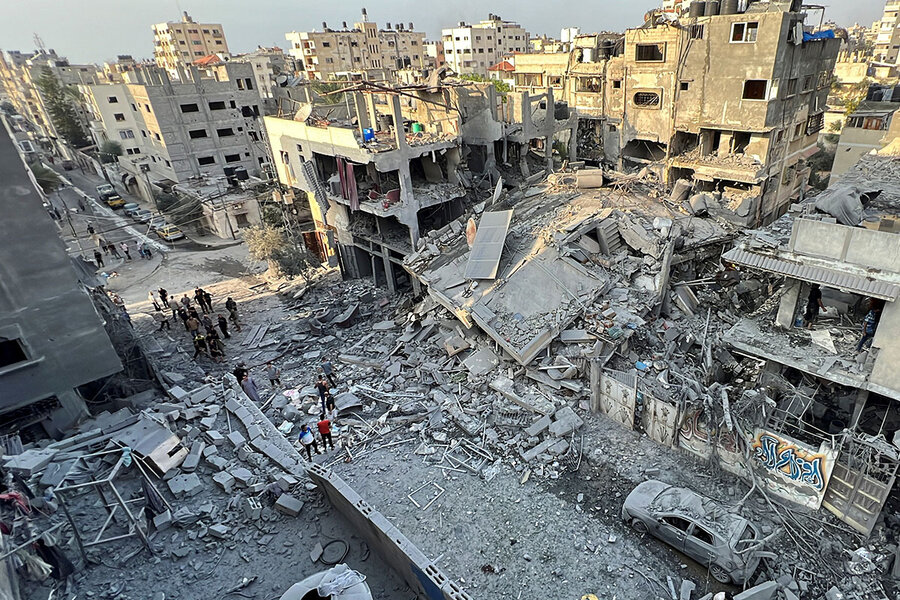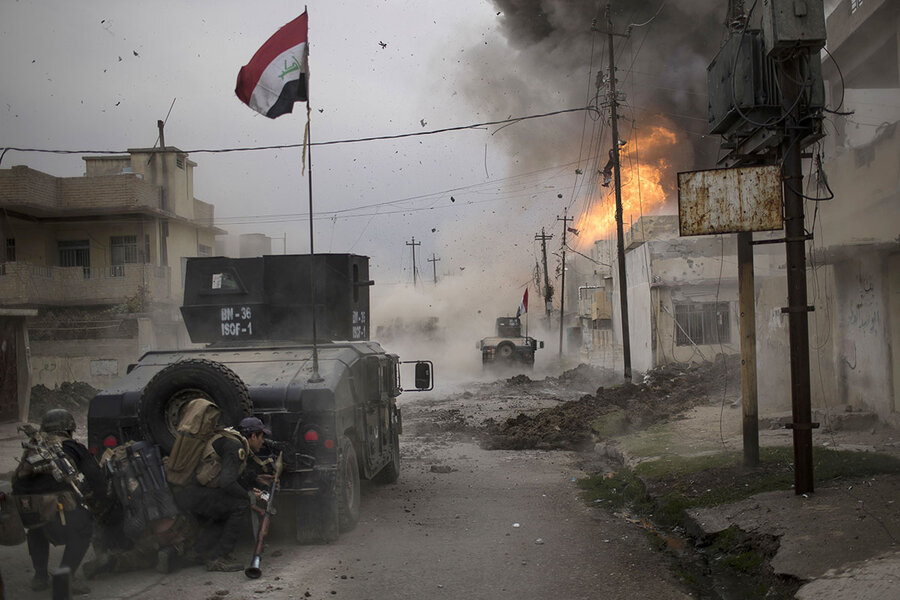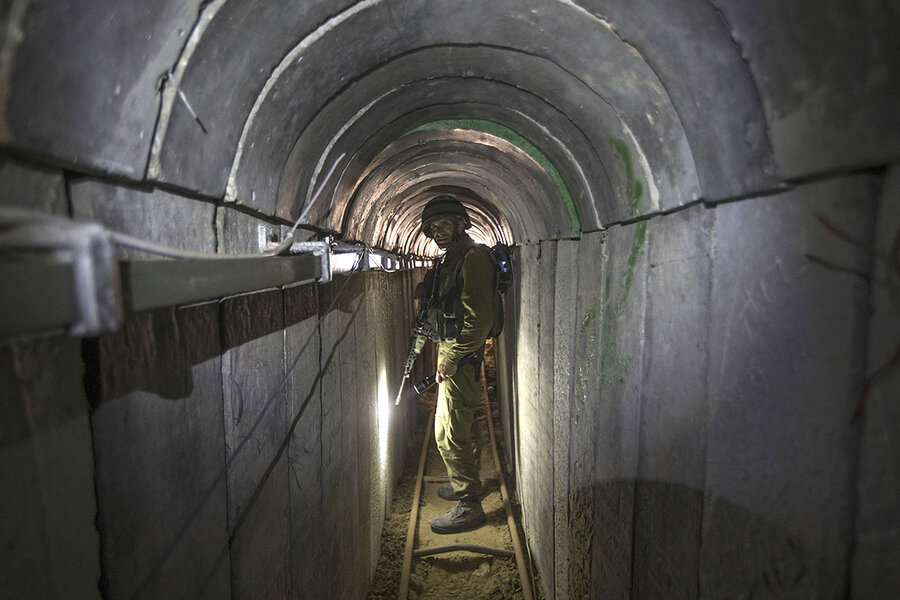Urban warfare in Gaza: Will it be different this time?
Loading...
Among military professionals, urban combat is widely considered to be the most grueling, intricate, and deadly of operations.
As Israel expands ground incursions into Gaza, its stated goal of destroying Hamas runs up against near-impossible conditions: battling enemies and rescuing hostages while navigating walled-in dead ends, concrete high-rises, and a network of booby-trapped tunnels. Add Gaza’s civilians to the mix, half of whom are children, and it can seem like a series of no-win trade-offs.
Why We Wrote This
Cities and their residents don’t fare well in urban warfare. As Israel launches its incursion into Gaza, the question is whether experience, new equipment, and American input will make a difference.
Indeed, the track record of city fighting is generally awful for civilians and mixed from a strategic perspective.
When Israel invaded Gaza in 2014, an estimated two-thirds of Hamas’ rocket stash was destroyed or used up, but some 2,200 Palestinians in Gaza were killed and upward of 7,000 homes were destroyed. In 2016, U.S. military planners expected it would take three months to dislodge the Islamic State from the Iraqi city of Mosul. The campaign lasted eight months and cost some 10,000 civilian lives.
Still, Israel brings new equipment, training, and technology to this incursion, and the United States will have a seat at the table, say experts such as Michael Knights at the Washington Institute for Near East Policy. “And so,” Dr. Knights says, “the Israelis probably end up doing this a bit differently than they normally do these things.”
Among military professionals, urban combat is widely considered to be the most grueling, intricate, and deadly of operations.
As Israel launches a new phase of its war effort with ground troop incursions into Gaza, its stated goal of destroying Hamas runs up against near-impossible conditions: battling enemies and rescuing hostages while navigating walled-in dead ends, concrete high-rises, and a network of deep and booby-trapped tunnels that its adversary has been preparing for years.
Add Gaza’s civilians to the mix, half of whom are children, and it can seem like a series of no-win trade-offs, even for commanders of well-trained and exquisitely equipped troops. If military leaders prioritize military objectives, then they accept harm to innocent people. If they prioritize civilians, then they accept more casualties among their own forces – and certainty that Hamas will use humanitarian ethical constraints to its advantage.
Why We Wrote This
Cities and their residents don’t fare well in urban warfare. As Israel launches its incursion into Gaza, the question is whether experience, new equipment, and American input will make a difference.
In short, cities and the people in them don’t fare well during urban warfare, and Gaza has been no exception. As Israeli Prime Minister Benjamin Netanyahu declared Saturday that a “second stage of the war” has begun, a communications blackout made it hard for ambulances to reach wounded people.
In totals released by each side as of Sunday, more than 8,000 Palestinians, including 3,300 children, have been killed, along with 1,400 Israelis. Hamas continues to hold more than 200 people hostage.
Against this wrenching backdrop, analysts are taking some heart in the close involvement of experienced U.S. officials providing counsel to the Israel Defense Forces (IDF). This includes Americans who battled against the Islamic State in the Iraqi city of Mosul from 2016 to 2017.
Though U.S. officials stress that all decisions are Israel’s alone, American military officers are “over there to share their perspective and to ask hard questions,” White House National Security Council spokesperson John Kirby told reporters last week.
And that could help, if not prevent harm, then better mitigate it, says Michael Knights, a fellow at the Washington Institute for Near East Policy. Israeli military leaders “will be kind of aware that they have this big brother in the room with them watching,” he adds. “And so I think the Israelis probably end up doing this a bit differently than they normally do these things.”
Poor track record in urban warfare
When it comes to urban warfare, the track record for how militaries “normally” do these things is generally awful for civilians and mixed from a strategic perspective, American and Israeli officials acknowledge.
During the monthlong Lebanon war of 2006, launched in response to Iranian-backed Hezbollah’s incursions, Israeli forces were poorly trained, had incomplete intelligence, and succumbed to an overreliance on air power during urban operations, an Israeli government commission concluded.
In response, the IDF built an urban warfare training center. In 2009, when it launched a two-week ground invasion of Gaza, it succeeded, for a while, in arresting rocket fire coming from Gaza. But a United Nations report accused both Palestinian militants and the IDF of war crimes.
Israel invaded Gaza for a second time in 2014, when it spent about three weeks trying to destroy Hamas tunnels following a spate of rocket attacks and the killing of three Israeli teenagers. An estimated two-thirds of Hamas’ rocket stash was destroyed or used up. More than 2,200 Palestinians in Gaza were reported killed, and upward of 7,000 homes were destroyed.
For its part, the U.S. military cut its teeth on modern urban warfare in Iraq. The 2004 battle of Fallujah saw some of the military’s fiercest city fighting since the Vietnam War. The United States invaded in April but withdrew in May in the wake of widespread images of destruction, sparking criticism that the civilian population of 250,000 to 300,000 hadn’t been given a chance to leave.
Insurgents used this to their advantage and spent months fortifying their positions. U.S. forces returned in November. In short order, they lost six M1A2 Abrams tanks, says John Spencer, a former Army ranger and chair of Urban Warfare Studies at the Modern War Institute at West Point. “That’s pretty big, even for the U.S. military,” he says.
America “responded to stiff insurgent resistance ... by preemptively destroying everything in the path of U.S. infantry forces,” notes a 2020 paper published by Parameters, the U.S. Army War College quarterly journal.
A dozen years later, the expectation among U.S. military planners was that it would take three months to dislodge the Islamic State from the city of Mosul. The campaign ultimately succeeded, but it lasted nine months and cost as many as 10,000 or more civilian lives.
In Gaza, Israel is expected to be confronting an estimated three to five times as many fighters as the U.S. faced in Mosul. And while there were almost no buildings six stories or taller in the Iraqi city, Gaza City has around 60 of them, Dr. Knights notes. What’s more, the Islamic State had around two years to prepare Mosul’s defenses; Hamas has had a decade and a half.
The challenge this time
In this Israeli incursion, the low and narrow tunnels that Hamas has built under Gaza will pose particular problems.
Even as it was constructing an anti-tunnel barrier, the IDF in 2020 discovered a subterranean passage some 230 feet deep that required forces to rappel down ropes. Slightly wider than a person’s shoulders, it was built with nooks for resting, letting comrades pass, and storing weapons. Some of the tunnels require oxygen tanks to navigate. Because of an absence of any ambient light, conventional night-vision goggles don’t work there.
Hamas will have pre-positioned its headquarters, communication nodes, weapons, and supplies in these tunnels in anticipation of a ground assault by Israeli forces. This will allow fighters to move between “a series of fighting positions safely and freely under massive buildings, even after the IDF drop thousand-pound bombs on them,” Mr. Spencer explains.
Connected to schools, hospitals, and mosques, the tunnels are also part of a strategy to make use of civilians as shields. Many of these tunnels are rigged with hundreds of pounds of explosives, he estimates, to function as bombs under “roads and buildings that the IDF might be lured into.”
But experts such as Dr. Knights hope that U.S. involvement, combined with Israel’s urban operations expertise, could potentially yield “the least bad result,” as he puts it. There will be “a feedback loop” that the U.S. military didn’t have in Mosul, “because who checks the U.S.’s homework? No one.”
New technology and equipment
Israelis will bring to the battle deeply specialized equipment, tactics, and units, including combat engineers who specialize in finding, clearing, and destroying tunnels. Israel’s military has a suite of flying or crawling robots to search and map tunnels. Two-story armored bulldozers – with the nickname doobi, or “teddy bear” – are designed to mount barriers and rescue overturned armored fighting vehicles.
The IDF’s military culture has continued to evolve for city fighting as well, including liberal use of “roof knock” explosions to try to warn civilians to clear out, as well as a propensity for punching holes in walls. “Because a door, a window – that’s where the enemy wants you to go,” Mr. Spencer says. Dismounted troops wear floppy hats over their helmets so their silhouettes aren’t as easily recognizable to snipers.
To this, the U.S. will bring “mind-blowing” technology, says Dr. Knights. An enormous number of sensors can detect movement in subterranean structures and map thermal and other chemical signatures, fusing it all together with artificial intelligence to provide an ultrafast map of combat and urban environments. The U.S. Department of Defense is also providing many heavy weapons, including two Iron Dome missile defense batteries.
All this equipment, not to mention political top cover, buys the U.S. a seat at the table, says Dr. Knights. In operational planning meetings, for example, “our guys will be sitting there kind of wrinkling their brows saying, ‘Just as a thought, have you considered whether some of those buildings might collapse even though you’re using small, lightweight munitions?’”
And while the Israeli military has strong capabilities, the more important counsel will come through stressing the protection of civilians. The aim is to help Israel be “a little bit more patient and intelligent” in the midst of deep anger – to echo President Joe Biden’s caution to operate by the international laws of warfare and not repeat America’s post-9/11 mistakes in becoming “consumed” by rage.
The ultimate hope, Dr. Knights adds, is that two nations widely criticized for brutality in urban battle “are going to want this to be done in a way that surprises people” – particularly those who, in the midst of grief, are braced for the worst.











